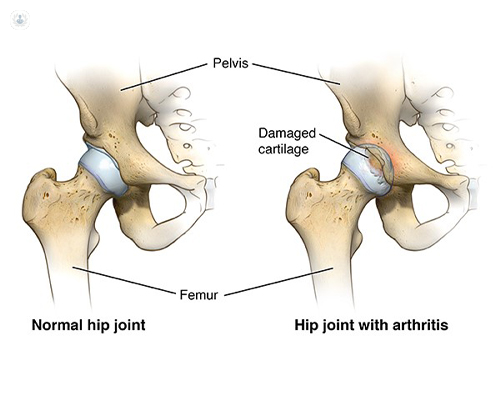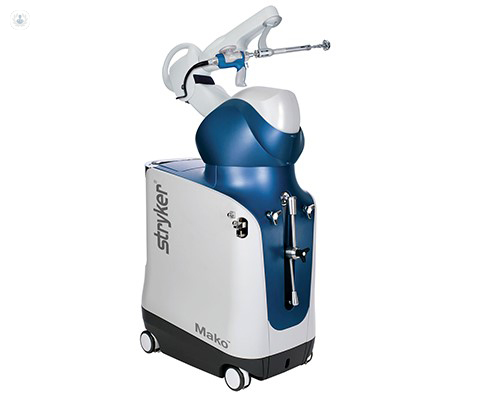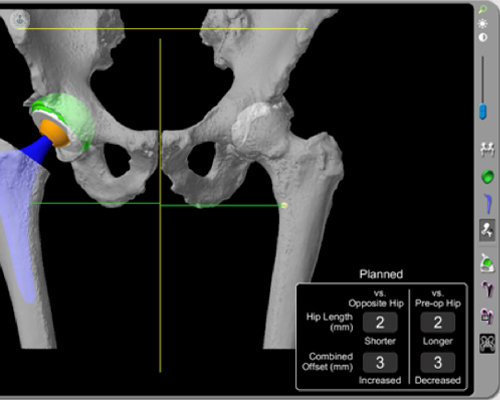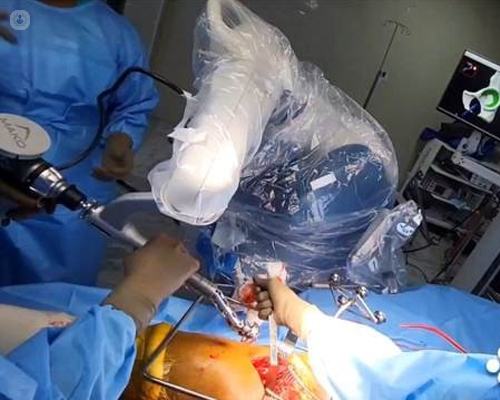Robotic-assisted total hip replacement: A patient's guide
Escrito por:Hip pain can severely affect your quality of life, making simple activities like walking, standing, or even sitting painful and difficult. One of the most common causes of chronic hip pain is arthritis, which can lead to significant damage to the hip joint. Advances in medical technology have introduced robotic-assisted hip replacement surgery, which offers greater precision and improved outcomes. Leading consultant orthopaedic surgeon Mr Khalid Malik tells us all about this important topic in this article.

What is arthritis?
Arthritis is a condition that affects the joints, which are the areas where two bones connect. As people age, it's normal for joints to experience some wear and tear. Many individuals develop arthritis as a result of this natural deterioration over time. Additionally, some forms of arthritis can occur after a joint has been injured, or as a result of specific health issues. Osteoarthritis is a prevalent type that particularly impacts the hip, leading to the gradual erosion of cartilage that normally cushions the hip joint's bones.
Anatomy of the hip joint
The hip joint is a ball-and-socket joint, where:
- The ball: The femoral head at the top of the thighbone (femur) forms the ball.
- The socket: The acetabulum in the pelvis forms the socket.
Cartilage covers the surfaces of the ball and socket, allowing smooth movement. When arthritis occurs, this cartilage wears away, causing the bones to rub against each other. This leads to pain, stiffness, and decreased range of motion, which can significantly impact daily activities.
Symptoms of hip arthritis
- Persistent pain in the hip, groin or thigh
- Stiffness, particularly after periods of rest or inactivity
- Reduced ability to move or rotate the hip
- A grinding sensation during hip movement
- Difficulty in walking, standing, or performing other activities
When is hip replacement surgery recommended?
In the early stages of arthritis, symptoms may be managed with non-surgical treatments such as physiotherapy, medications, lifestyle changes or injections. However, when these treatments no longer provide relief and the pain becomes disabling, total hip replacement surgery may be recommended. This procedure involves replacing the damaged hip joint with an artificial implant to restore function and alleviate pain.
Understanding robotic-assisted hip replacement surgery
What is robotic-assisted hip replacement?
Robotic-assisted hip replacement is an advanced surgical procedure that enhances the precision of traditional hip replacement surgery. This technology allows the surgeon to plan and execute the surgery with meticulous accuracy, ensuring the optimal placement and alignment of the hip implant based on the patient’s unique anatomy.

How does the procedure work?
Preoperative planning
-
- Using advanced imaging techniques, such as CT scans, a detailed 3D virtual model of the patient’s hip is created.
- The scan is used to develop a customised surgical plan, determining the optimal size, position, and alignment of the hip implant.

Surgical procedure
-
- During surgery, the robotic system assists the surgeon in performing the procedure with unparalleled precision.
- The robotic arm helps in removing the damaged bone and cartilage while preserving healthy tissue.
- The hip implant is positioned according to the preoperative plan, ensuring proper alignment and balance, which is crucial for the joint's function and longevity.
- The robotic system provides real-time feedback, allowing for adjustments to achieve the best possible outcome.

Benefits of robotic-assisted hip replacement
- Enhanced precision
- The robotic system allows for the precise placement and alignment of the hip implant, which is essential for restoring natural movement and improving the implant's longevity.
- Personalised surgery
- The procedure is tailored to the patient’s specific anatomy and condition, which can result in better functional outcomes.
- Improved implant longevity
- Accurate placement reduces wear and tear on the implant, potentially extending its lifespan.

Is robotic-assisted hip replacement right for you?
Robotic-assisted hip replacement is particularly beneficial for patients with moderate to severe osteoarthritis who have not found relief through non-surgical treatments. During a consultation, the surgeon will assess your condition, medical history, and lifestyle to determine if this advanced surgical option is appropriate for you.
Are you considering a robotic-assisted hip replacement? Arrange a consultation with Mr Malik via his Top Doctors profile.


